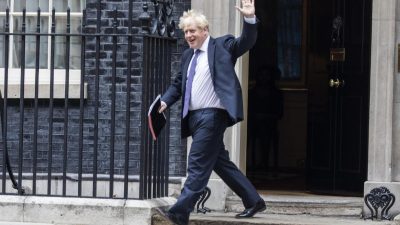Boris’ Bridge Between Scotland and Northern Ireland Cancelled before It Began

All Global Research articles can be read in 51 languages by activating the “Translate Website” drop down menu on the top banner of our home page (Desktop version).
Visit and follow us on Instagram at @crg_globalresearch.
***
It was decried as yet another one of Boris Johnson’s hairbrained schemes: a bridge connecting Scotland with Northern Ireland, therefore mainland Britain with the island of Ireland. ‘The world’s most stupid tunnel’ said Dominic Cummings; ‘nothing more than a vanity project’ scoffed the SNP Transport Minister.
Critics needn’t have worried: the Johnson government plans were shelved almost before they got off the ground. Sources cited financial concerns. Yet there are those who still think the project should have gone ahead.
Professor Alan Dunlop, the bridge’s architect, is one who believes in the scheme’s potential. In an interview with The National newspaper, Dunlop says the UK government has missed out on an opportunity to boost the economy post-Brexit. He states that ‘such a major transportation and infrastructure project would be an investment in the future after Brexit and also post-Covid.’ He compares it to former US President Franklin Roosevelt’s New Deal during the 1930s’ Great Depression which put so many people back to work, describing the plan as ‘transformative and a world first’.
There could have been other benefits as well for the Johnson government. At a time when the Union is arguably at its weakest, after Brexit, and Scottish independence and Irish reunification are on the table, the bridge project could have demonstrated London’s commitment to the devolved regions. Symbolically, it would have permanently connected Northern Ireland to the UK mainland, emphasizing that it is very much a part of Great Britain, and will remain so.
But the idea of the bridge was immediately unpopular with politicians in Scotland and Northern Ireland alike. Fundamentally, they probably disliked the prospect of the UK government meddling in their regional infrastructure, but they also cited concerns about the cost and presence of dumped munitions in the Irish Sea. SDLP leader Colum Eastwood said ‘The Prime Minister’s fantasy bridge to Northern Ireland could cost £33 billion. This while our road and rail networks have been absolutely decimated from decades of underinvestment.’ Scottish Transport Secretary Michael Matheson reminded London that the Scottish government already had its own “robust process” for planning future transport infrastructure projects and that such a tunnel project simply wasn’t ‘a priority’ for Scotland or Northern Ireland.
The fact is that the devolved administrations of Northern Ireland, Scotland and Wales, are so used to their autonomy that it will be very difficult now for London to start throwing its weight around again in these regions in future. Once freedom is given, it’s almost impossible to claw it back. Particularly after the 2016 Brexit result, when both Scotland and Northern Ireland voted to remain in the EU, the regions of the UK felt abandoned by Westminster and Boris Johnson’s determination to exit the EU ‘come what may’. There is no doubt a feeling that if such a project is going to go ahead between Scotland and Northern Ireland, it will be at the bidding of Edinburgh and Belfast, and not London.
Although the project has been temporarily shelved however, it doesn’t mean that it will stay there. It is likely that the UK government will come up with other schemes such as this in the near future to try to maintain the Union and dilute feelings of Irish and Scottish nationalism. It was reported in March this year that around 1000 British civil servants would be relocating from London to Glasgow to what is to be a second headquarters for the UK Cabinet Office. With Glasgow being something of a hub of Scottish nationalism in Scotland, there can be no doubt that this is part of a strategic move to plant pro-Union personnel in the city. Such ‘planting’ of the English has been done by the British government since time immemorial. In the 1600s English Protestants who had pledged allegiance to the King were ‘planted’ in Ulster in Northern Ireland, where their descendants remain to this day, still loyal to the British crown. Extraordinary to think such a technique is still in use today.
Therefore, bridge, or no bridge, Boris Johnson’s government will do what it takes to rally support for the Union in the devolved regions in the near future. The question remains however, with nationalist sentiment higher than it has ever been (particularly in Scotland) is it now too little, too late?
*
Note to readers: Please click the share buttons above or below. Follow us on Instagram, @crg_globalresearch. Forward this article to your email lists. Crosspost on your blog site, internet forums. etc.
Johanna Ross is a journalist based in Edinburgh, Scotland. You can follow the author on Twitter.
Featured image is from InfoBrics

